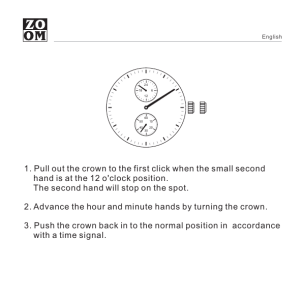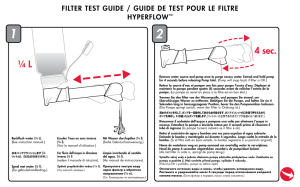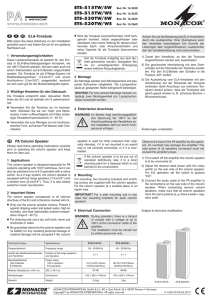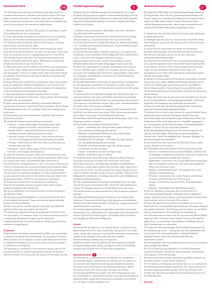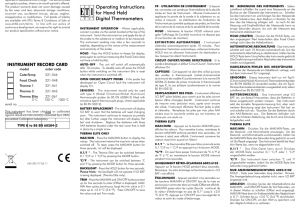KORG Pa-Series PaAS Amplification System
Anuncio
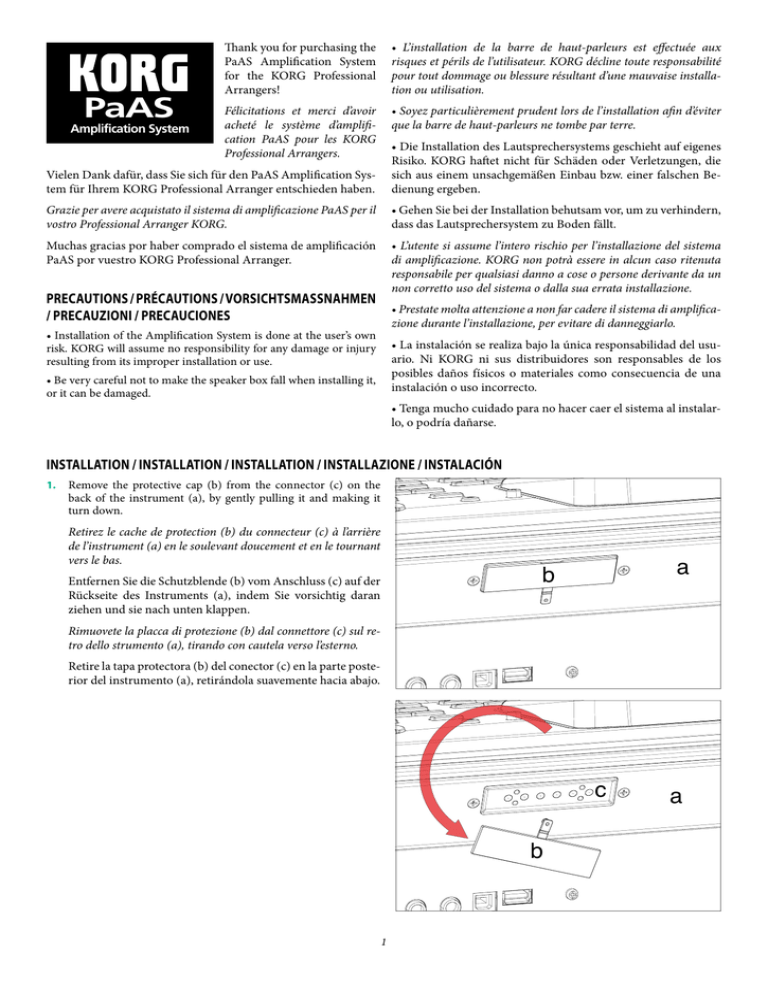
PaAS Amplification System Thank you for purchasing the PaAS Amplification System for the KORG Professional Arrangers! • L’installation de la barre de haut-parleurs est effectuée aux risques et périls de l’utilisateur. KORG décline toute responsabilité pour tout dommage ou blessure résultant d’une mauvaise installation ou utilisation. Félicitations et merci d’avoir acheté le système d’amplification PaAS pour les KORG Professional Arrangers. • Soyez particulièrement prudent lors de l’installation afin d’éviter que la barre de haut-parleurs ne tombe par terre. Vielen Dank dafür, dass Sie sich für den PaAS Amplification System für Ihrem KORG Professional Arranger entschieden haben. • Die Installation des Lautsprechersystems geschieht auf eigenes Risiko. KORG haftet nicht für Schäden oder Verletzungen, die sich aus einem unsachgemäßen Einbau bzw. einer falschen Bedienung ergeben. Grazie per avere acquistato il sistema di amplificazione PaAS per il vostro Professional Arranger KORG. • Gehen Sie bei der Installation behutsam vor, um zu verhindern, dass das Lautsprechersystem zu Boden fällt. Muchas gracias por haber comprado el sistema de amplificación PaAS por vuestro KORG Professional Arranger. • L’utente si assume l’intero rischio per l’installazione del sistema di amplificazione. KORG non potrà essere in alcun caso ritenuta responsabile per qualsiasi danno a cose o persone derivante da un non corretto uso del sistema o dalla sua errata installazione. PRECAUTIONS / PRÉCAUTIONS / VORSICHTSMASSNAHMEN / PRECAUZIONI / PRECAUCIONES • Prestate molta attenzione a non far cadere il sistema di amplificazione durante l’installazione, per evitare di danneggiarlo. • Installation of the Amplification System is done at the user’s own risk. KORG will assume no responsibility for any damage or injury resulting from its improper installation or use. • La instalación se realiza bajo la única responsabilidad del usuario. Ni KORG ni sus distribuidores son responsables de los posibles daños físicos o materiales como consecuencia de una instalación o uso incorrecto. • Be very careful not to make the speaker box fall when installing it, or it can be damaged. • Tenga mucho cuidado para no hacer caer el sistema al instalarlo, o podría dañarse. INSTALLATION / INSTALLATION / INSTALLATION / INSTALLAZIONE / INSTALACIÓN 1. Remove the protective cap (b) from the connector (c) on the back of the instrument (a), by gently pulling it and making it turn down. Retirez le cache de protection (b) du connecteur (c) à l’arrière de l’instrument (a) en le soulevant doucement et en le tournant vers le bas. a b Entfernen Sie die Schutzblende (b) vom Anschluss (c) auf der Rückseite des Instruments (a), indem Sie vorsichtig daran ziehen und sie nach unten klappen. Rimuovete la placca di protezione (b) dal connettore (c) sul retro dello strumento (a), tirando con cautela verso l’esterno. Retire la tapa protectora (b) del conector (c) en la parte posterior del instrumento (a), retirándola suavemente hacia abajo. c b 1 a 2. Now locate the front (d1) and the rear (d2) side of the speaker box, to be sure you will place it in the right way. Repérez bien les faces avant (d1) et arrière (d2) de la barre de haut-parleurs pour l’installer correctement. d1 Merken Sie sich, welche die Vorder- (d1) und welche die Rückseite (d2) der Lautsprecherleiste ist, um sie richtig herum zu installieren. Individuate la parte frontale (d1) e posteriore (d2) del sistema di amplificazione, per essere sicuri di posizionarlo correttamente. d2 Ahora localice la parte frontal (d1) y la parte trasera (d2) del sistema de altavoces y colóquela en dirección correcta. 3. Lift the speaker box (d) by making the back side (d2) look toward you and the front side (d1) toward the Professional Arranger. Align its extruding guide (e) to the matching slot (f) on the back of the instrument (a). Slightly tilt the speaker box (d) forward, to prevent the fixing pin (j, see below) to damage the back of the instrument. To align them correctly, use one of the two plastic stoppers/delimiters (h) as a reference point, making one of the flanks or the speaker box’s guide (e) touch it. d2 Soulevez la barre de haut-parleurs (d) en dirigeant sa face arrière (d2) vers vous et sa face avant (d1) vers l’avant du Professional Arranger. Alignez la partie protubérante (e) avec la fente (f) à l’arrière de l’instrument (a). Inclinez légèrement la barre de haut-parleurs (d) vers l’avant pour éviter que sa tige de fixation (j, voyez plus loin) n’endommage la face arrière de l’instrument. Pour faciliter l’alignement, utilisez une des deux butées en plastique (h) comme point de référence et glissez la face latérale de la barre de haut-parleurs (e) contre la butée. d1 f e h a Halten Sie die Lautsprecherleiste (d) so, dass ihre Rückseite (d2) zu Ihnen hin und ihre Vorderseite zur Vorderseite des Professional Arranger weist. Halten die hervorstehende Partie (e) so, dass sie sich über der Schiene (f) an der Rückseite des Instruments befindet (a). Neigen Sie die Lautsprecherleiste (d) leicht vorwärts, um zu verhindern, dass ihr Befestigungsstift (j, siehe unten) die Rückseite des Instruments verkratzt. Im Sinne einer leichteren Fluchtung sollten Sie einen der beiden Plastikstopper (h) als Anhaltspunkt nehmen und die betreffende Seitenwand der Lautsprecherleiste (e) dagegen schieben. Sollevate il sistema di amplificazione (d) in modo da orientare la parte posteriore (d2) verso voi stessi, e la parte frontale (d1) verso il Professional Arranger. Allineate le guide (e) del sistema di amplificazione (d) all’alloggiamento (f) situato sul retro dello strumento (a). Inclinate leggermente il sistema di amplificazione (d) in avanti, per evitare che il pin di ancoraggio (j, vedi sotto) danneggi il retro dello strumento. Per un corretto allineamento, usate come punto di riferimento uno dei due stop/delimitatori di plastica (h), facendo in modo che uno dei fianchi o una delle guide (e) del sistema di amplificazione lo tocchi. Levantar la caja de altavoz (d) haciendo que la parte posterior (d2) mire hacia usted y la parte frontal (d1) hacia el instrumento. Alinear a su guía de extrusión (e) en la ranura correspondiente (f) en la parte posterior del instrumento (a). Inclinar Ligeramente la caja de altavoz (d), para evitar que el pin de fijación (k, véase más abajo) dañe la parte posterior del instrumento. Para alinearlos correctamente, utilice uno de los dos plásticos tapones/delimitadores (h) como punto de referencia, utilizando como guía uno de los flancos de la caja de altavoz (e) y haciendo que lo toque. 2 4. Insert the speaker box’s extruding guide (e) entirely into the slot (f) on the back of the instrument, being sure the speaker box is perfectly horizontal. e Insérez la partie protubérante (e) de la barre de hautparleurs complètement dans la fente (f) et veillez à ce que la barre soit parfaitement horizontale. f Schieben Sie die hervorstehende Partie (e) der Lautsprecherleiste komplett auf die Schiene (f) und sorgen Sie dafür, dass die Lautsprecherleiste völlig horizontal liegt. Inserite completamente le guide del sistema di amplificazione (e) nell’alloggiamento (f) situato sul retro dello strumento, accertandovi che il sistema di amplificazione rimanga perfettamente orizzontale. Insertar la Guía de extrusión de la caja de altavoz (e) totalmente en la ranura (f) en la parte posterior del instrumento, asegurándose de que la caja de altavoz esté perfectamente horizontal. Be sure the nylon supports (i) for the music stand are perfectly resting on the control panel of the instrument (a). i Les supports en nylon du pupitre (i) doivent reposer parfaitement sur la face avant de l’instrument (a). Die Nylon-Halterungen für das Notenpult (i) müssen sich auf dem Bedienfeld des Instruments (a) befinden. a Assicuratevi che i supporti in nylon (i) per il leggio rimangano sul pannello di controllo dello strumento (a). Asegúrese de que los apoyos de nailon (i) para el atril de música estén descansando en el panel de control del instrumento (a). 5. When the speaker box (d) is perfectly aligned to the stop- pers/delimiters, and the fixing pin (j) is over the corresponding hole (k) on the back of the instrument (a), tilt down the speaker box (d), to make the fixing pin (j) enter the hole (k). j Quand la barre de haut-parleurs (d) est parfaitement alignée avec les butées et la tige de fixation (j) se trouve au-dessus de l’orifice correspondant (k) sur la face arrière de l’instrument (a), vous pouvez incliner la barre de hautparleurs vers le bas. Assurez-vous que la tige de fixation (j) entre dans l’orifice (k). k d Wenn sich die Lautsprecherleiste (d) hart an einem Stopper und der Befestigungsstift (j) sich über der betreffenden Aussparung (k) an der Rückseite des Instruments (a) befindet, dürfen Sie die Lautsprecherleiste hinunterklappen. Achten Sie dabei darauf, dass der Befestigungsstift (j) in die Aussparung (k) gleitet. a Dopo aver allineato correttamente il sistema di amplificazione (d) con gli stop/delimitatori, e aver verificato che il pin di ancoraggio (j) sia in corrispondenza del foro (k) sul retro dello strumento (a), ruotate il sistema di amplificazione (d) per far entrare il pin (j) nel foro (k). Cuando la caja de altavoz (d) está perfectamente alineada con los delimitadores, y el pin de fijación (j) esté sobre el orificio correspondiente (k) en la parte posterior del instrumento (a), incline hacia abajo la caja de altavoz (d), para hacer que el pin de fijación (j) se introduzca en el orificio (k). 3 6. Use the SPEAKER LOCK slider (l) next to the display to lock (or later unlock) the speaker box (d). When the box is locked, you must see the closed lock icon ( ). This will firmly join the speaker box (d) to the instrument (a). Utilisez le curseur SPEAKER LOCK (l) situé à côté de l’écran pour verrouiller (et, ultérieurement, déverrouiller) la barre de haut-parleurs (d). La barre de haut-parleurs est correctement verrouillée quand vous voyez le cadenas ( ). Cela montre que la barre de haut-parleurs (d) est solidement fixée à l’instrument (a). Arretieren Sie die Lautsprecherleiste (d) mit dem SPEAKER LOCK-Regler (l). Bedenken Sie, dass die Lautsprecherleiste erst ordnungsgemäß arretiert ist, wenn Sie das Hängeschloss ( ) sehen. Nur dann ist die Lautsprecherleiste (d) fest mit dem Instrument (a) verbunden. l d a Utilizzate il cursore SPEAKER LOCK (l) accanto al display per bloccare (e in seguito sbloccare) il sistema di amplificazione (d). Una volta bloccato, dovreste vedere l’icona del lucchetto chiuso ( ). In questo modo il sistema (d) viene saldamente assicurato allo strumento (a). Utilice el deslizante SPEAKER LOCK de bloqueo de altavoz (l) situado junto a la pantalla para bloquear (o desbloquear más tarde) la caja de altavoz (d). Cuando el sistema de altavoz está bloqueado, debe ver el icono de candado cerrado ( ). Esto unirá firmemente el sistema de altavoz (d) al instrumento (a). 7. At this point, the speaker box is correctly installed. To re- move it, reverse the above instructions. La barre de haut-parleurs est alors correctement installée. Pour la démonter, inversez les opérations décrites ci-dessus. Die Lautsprecherleiste ist jetzt einsatzbereit. Um sie später wieder zu entfernen, müssen Sie die obigen Schritte umkehren. A questo punto, il sistema di amplificazione è stato correttamente installato. Per rimuoverlo, eseguite in senso contrario la procedura appena descritta. En este punto, el sistema de altavoz está instalado correctamente. Para retirarlo, siga las instrucciones anteriores en sentido inverso. © 2015 KORG Italy. Printed in Italy. 4
